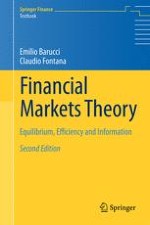2017 | Buch
Über dieses Buch
This work, now in a thoroughly revised second edition, presents the economic foundations of financial markets theory from a mathematically rigorous standpoint and offers a self-contained critical discussion based on empirical results. It is the only textbook on the subject to include more than two hundred exercises, with detailed solutions to selected exercises.
Financial Markets Theory covers classical asset pricing theory in great detail, including utility theory, equilibrium theory, portfolio selection, mean-variance portfolio theory, CAPM, CCAPM, APT, and the Modigliani-Miller theorem. Starting from an analysis of the empirical evidence on the theory, the authors provide a discussion of the relevant literature, pointing out the main advances in classical asset pricing theory and the new approaches designed to address asset pricing puzzles and open problems (e.g., behavioral finance). Later chapters in the book contain more advanced material, including on the role of information in financial markets, non-classical preferences, noise traders and market microstructure.
This textbook is aimed at graduate students in mathematical finance and financial economics, but also serves as a useful reference for practitioners working in insurance, banking, investment funds and financial consultancy. Introducing necessary tools from microeconomic theory, this book is highly accessible and completely self-contained.
Advance praise for the second edition:
"Financial Markets Theory is comprehensive, rigorous, and yet highly accessible. With their second edition, Barucci and Fontana have set an even higher standard!"Darrell Duffie, Dean Witter Distinguished Professor of Finance, Graduate School of Business, Stanford University
"This comprehensive book is a great self-contained source for studying most major theoretical aspects of financial economics. What makes the book particularly useful is that it provides a lot of intuition, detailed discussions of empirical implications, a very thorough survey of the related literature, and many completely solved exercises. The second edition covers more ground and provides many more proofs, and it will be a handy addition to the library of every student or researcher in the field."Jaksa Cvitanic, Richard N. Merkin Professor of Mathematical Finance, Caltech
"The second edition of Financial Markets Theory by Barucci and Fontana is a superb achievement that knits together all aspects of modern finance theory, including financial markets microstructure, in a consistent and self-contained framework. Many exercises, together with their detailed solutions, make this book indispensable for serious students in finance."Michel Crouhy, Head of Research and Development, NATIXIS
Anzeige
